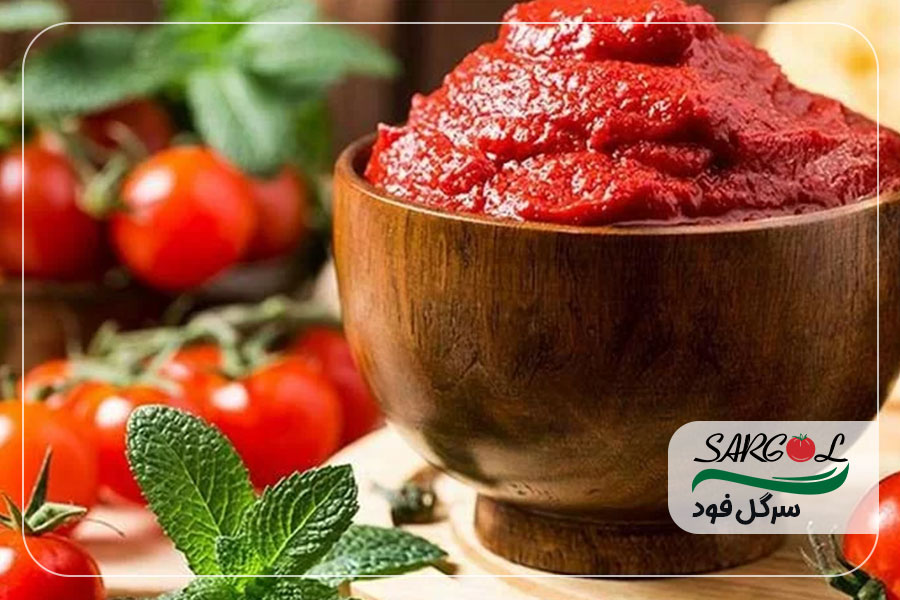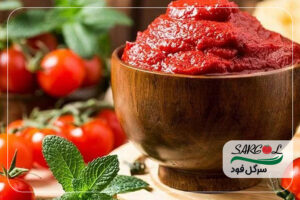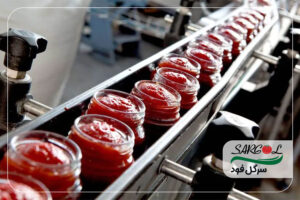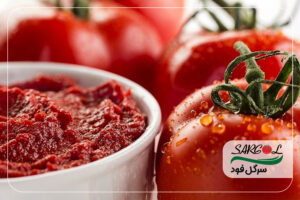Tomato paste is one of the important ingredients in cooking, which is used as a seasoning and flavoring in many dishes. Tomato paste is obtained by concentrating fresh tomato juice and has a dark red color and a rich, sour and sweet taste.
History and origin
Tomato paste was first produced as an edible product in the Mediterranean region. Originally from South America (especially the Andes region), tomatoes were introduced to Europe by the Spanish in the 16th century and gradually became part of European cuisine. The industrial production of tomato paste began in the early 19th century and quickly became a staple in Mediterranean and then global cuisine.
Production process
The production of tomato paste is divided into several key stages:
Selecting and harvesting tomatoes:
Ripe and high quality tomatoes are selected for the production of paste. These tomatoes should have the right color, aroma and taste and should be selected from varieties that have sufficient amount of water and sugar.
Washing and chopping:
Tomatoes are washed well to get rid of any dirt and pollution. Then they are crushed or crushed to prepare for the next steps.
Primary cooking:
Chopped tomatoes are heated in large pots to separate the broken tomato tissues and tomato juice. This step leads to partial concentration.
Filtration:
Cooked tomatoes are passed through special filters to separate the tomato skin and seeds and leave only the liquid part.
Condensation:
Tomato liquid is boiled at high temperature until its water evaporates and reaches the desired concentration. This step may take several hours.
Add salt:
Salt is added to the paste to add flavor and to act as a preservative.
Pasteurization and packaging:
The paste is hot packed in glass or metal cans. Pasteurization takes place at this stage so that the paste has a long shelf life.
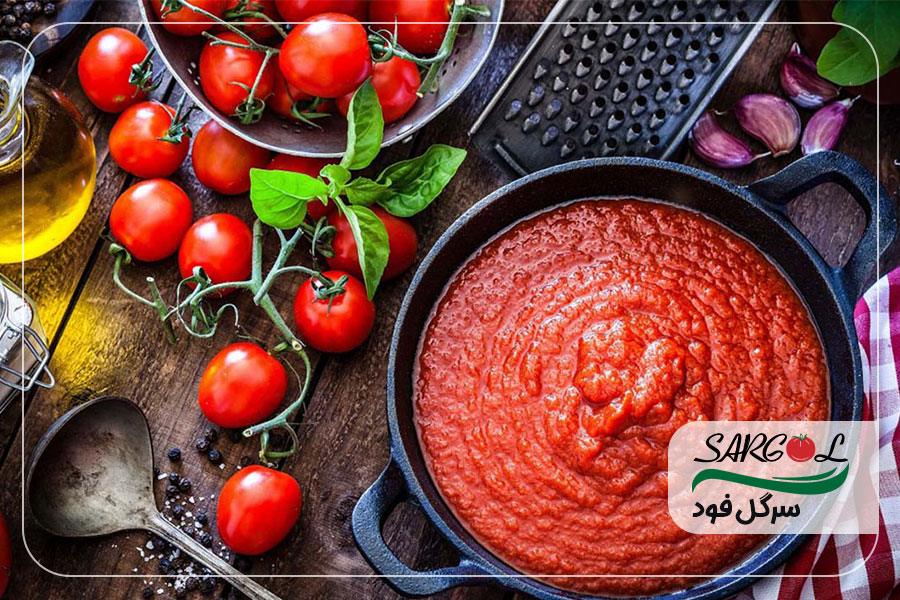 رب گوجه
رب گوجه
Nutritional characteristics
Tomato paste is rich in vitamin C, vitamin A, and lycopene. Lycopene is a strong antioxidant obtained from tomatoes and plays an important role in reducing the risk of heart diseases and some types of cancer. Main nutrients in tomato paste:
Vitamin C: helps strengthen the immune system and skin health.
Vitamin A: Essential for vision, growth and immune system.
Antioxidants (lycopene): help fight free radicals and reduce inflammation.
Culinary uses
Tomato paste is used as a base for many dishes. It is used in Iranian dishes, such as ghee, vegetable soup, and Mediterranean dishes, such as pastas, soups, and various sauces. This substance gives food color and rich taste and acts as a natural thickening agent.
Maintenance and durability
Storage in the refrigerator: After opening, the tomato paste should be stored in the refrigerator. To prevent mold, you can cover the surface of the paste with a thin layer of oil.
Durability: Tomato paste packed in the right conditions can last for several months at room temperature and for several weeks after opening in the refrigerator.
Types of tomato paste
Tomato paste is produced industrially and domestically:
Industrial tomato paste: produced in factories and sold in canned or glass packages.
Homemade tomato paste: prepared at home and usually without chemical additives. This type of paste may have a special taste and quality that distinguishes it from the industrial type.
Safety tips
Due to its high acidity, tomato paste is not a suitable environment for the growth of microbes, but if it is not stored properly, it may become moldy. Also, long-term consumption of canned pastes with chemical preservatives may be harmful for some people. Tomato paste is one of the main components of many Iranian and international dishes. This substance is one of the most widely used substances in kitchens with its useful nutritional properties and wide applications in cooking. Getting to know the production process, how to store it, and its uses can help improve the taste and quality of food.
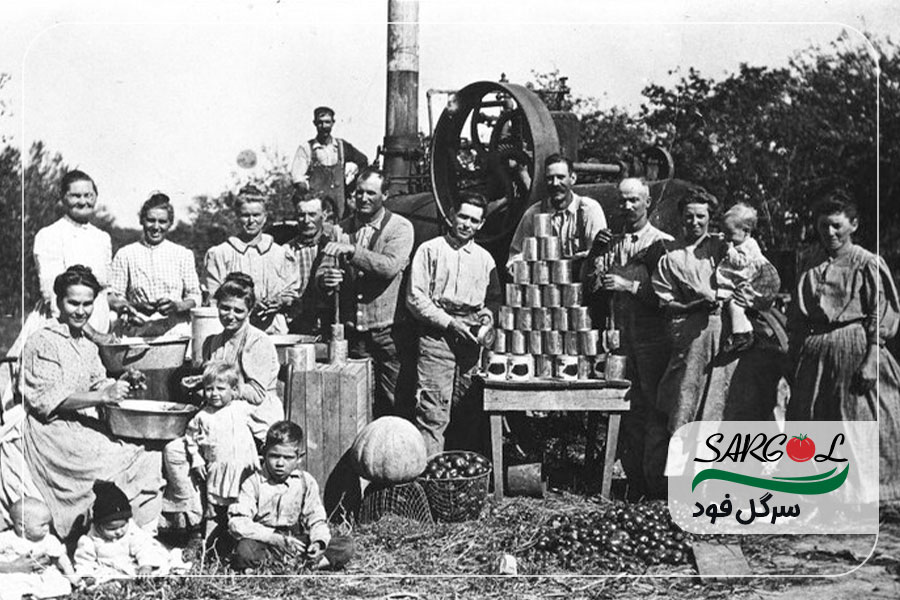
History of tomato paste
The history of tomato paste goes back to the development of the use of tomatoes in Mediterranean and then global cuisines. Tomato, which originally comes from South America (especially the Andes region), was brought to Europe by the Spanish in the 16th century and was initially planted as an ornamental plant in European gardens.
The arrival of tomatoes in Europe
Tomatoes arrived in Europe in the early 16th century, but were not widely adopted in European cooking until the 17th and 18th centuries. At first, Europeans suspected tomato as a poisonous plant and saw it more as an ornamental plant. But it was gradually used in the cooking of Mediterranean countries such as Italy, Spain and France, and its unique taste and characteristics were recognized.
Development of tomato paste
With the expansion of the use of tomatoes in cooking, the need to store and use this fruit in all seasons of the year also increased. The first tomato paste was probably prepared traditionally and at home by thickening tomato juice and boiling it at a low temperature. This method of production became popular in the Mediterranean areas and especially in Italy.
Industrial revolution and mass production
In the 19th century, with the advancement of industrial technologies, the production of tomato paste began industrially. Italy was one of the first countries to launch the production of tomato paste on a large scale and industrially. This country became one of the largest producers and exporters of tomato paste due to the favorable weather conditions and access to high-quality tomatoes.
Global expansion
In the early 20th century, with the increase in exports and international trade, tomato paste became a global product. This substance quickly gained its place in different cuisines of the world and was used as a main flavoring and seasoning in many dishes. Today, tomato paste is used in various cuisines, including Iranian, Mediterranean, Asian, and Latin American cuisines.
Recent innovations
In recent decades, the production of tomato paste has improved with the use of more advanced technologies such as concentrates and new packaging. These changes have increased the shelf life and quality of tomato paste and made it possible to export it widely around the world.
conclusion
Tomato paste, which has its roots in Mediterranean cooking, has become one of the basic and widely used products in global cooking. From its traditional roots in home production to industrial and extensive production, tomato paste plays an important role in various foods and its history shows the importance of this product in the development of global food culture.

